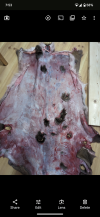I've wanted to attempt to tan a deer hide for a while now, so figured it's time to get started. I have the hide from the buck I shot earlier this season in the freezer as well as a doe hide that's in the bottom of my fridge (section of the fridge that gets too cold so it's half frozen). Going to give this a go with the doe hide first and then thaw out the buck hide as well, will keep this thread updated re: progress.
Step 1 was to acquire supplies.
I purchased two bottles of deer hunter and trapper's tanning formula
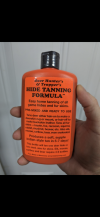
as well as an 8 inch wiebe fleshing knife.
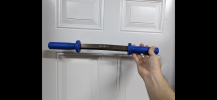
And then built myself a fleshing beam out of a few 2*6 boards I had leftover from an old project. I eyeballed the whole thing, no measurements, just used a draw knife and a palm sander with 80 grit to smooth off the curved end and propped scraps up to get it at roughly waist height when unfolded. It folds at the front and the support leg is loose so it stores much more compactly. Planning to have a foot on the bottom board to keep it from sliding, but also left myself room for a clamp if I need to clamp the front down on the deck or something. I may just flesh it in my kitchen because... Bachelor life, and the kitchen is getting renovated next year anyway in which case I'll just push it up against the wall.
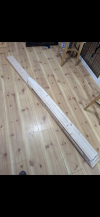
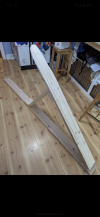
That's as far as I got today, I need to go to the store to buy a bunch of non iodized salt tomorrow and I'll give fleshing the doe hide a try after I have salt on hand. From what I understand, next steps are dry salting for 24 hrs x2, days, then a 8hr saltwater bath, then a dawn dish soap cleaning, followed by drying out hide somewhat and applying the orange bottle liberally, once it begins to dry then work it in/break it. I plan to try to tan these hair-on for wallhangers/"blankets" (the depending on how stiff they are/how much I want to break them) and to see if I can do it. Future hides may get turned into buckskin depending on results or may het left with the gut pile/bones, we shall see. It'll be a day or two/more between each step but I'll keep the thread updated with my results.
Step 1 was to acquire supplies.
I purchased two bottles of deer hunter and trapper's tanning formula

as well as an 8 inch wiebe fleshing knife.

And then built myself a fleshing beam out of a few 2*6 boards I had leftover from an old project. I eyeballed the whole thing, no measurements, just used a draw knife and a palm sander with 80 grit to smooth off the curved end and propped scraps up to get it at roughly waist height when unfolded. It folds at the front and the support leg is loose so it stores much more compactly. Planning to have a foot on the bottom board to keep it from sliding, but also left myself room for a clamp if I need to clamp the front down on the deck or something. I may just flesh it in my kitchen because... Bachelor life, and the kitchen is getting renovated next year anyway in which case I'll just push it up against the wall.


That's as far as I got today, I need to go to the store to buy a bunch of non iodized salt tomorrow and I'll give fleshing the doe hide a try after I have salt on hand. From what I understand, next steps are dry salting for 24 hrs x2, days, then a 8hr saltwater bath, then a dawn dish soap cleaning, followed by drying out hide somewhat and applying the orange bottle liberally, once it begins to dry then work it in/break it. I plan to try to tan these hair-on for wallhangers/"blankets" (the depending on how stiff they are/how much I want to break them) and to see if I can do it. Future hides may get turned into buckskin depending on results or may het left with the gut pile/bones, we shall see. It'll be a day or two/more between each step but I'll keep the thread updated with my results.


